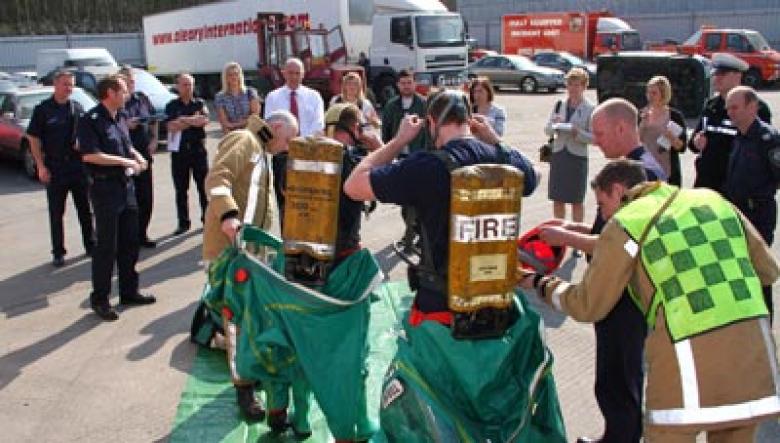
Firefighters wore chemical protection suits to investigate a leaking drum spilled from the boot of a car which ended up on its roof after a crash in a simulated training exercise involving many of Shropshire’s emergency services.
They contained the mystery chemical into a secure drum before using Shropshire's Fire Control based at Shrewsbury brigade HQ to check from the damaged label that the substance was sulphuric acid which had leaked in the accident on the A49 at Marshbrook – all part of the training exercise scenario.
Constable Neil Williams, from Shrewsbury’s accident investigation unit, outlined how police would initially deal with the incident as first on the scene by checking for casualties, getting as much information as possible about the mystery chemical and calling in the fire and rescue service to deal with it. An exclusion zone would be placed around the crashed car and witness statements taken.
“In a real life situation we would not know what the chemical substance was so we would have no option but to treat it as the worst case scenario until such time as we were able to obtain further information which would either confirm our actions or allow us to reduce our levels of protection" said Phil Clarke, Training Manager at the Brigade’s Training and Development Centre at Stafford Park Telford.
He had organised the innovative training session as an alternative to a classroom discussion to bring to life possible events that the emergency services could be called to deal with in the county.
Representatives from the Environment Agency, Shropshire Council’s emergency planning officer and highways officers who would all be involved in helping to clear up such an emergency were also at the training event held in Auto Mechanical’s yard at Halesfield, Telford.
Earlier the group had visited Oakley Fuels to talk through how to deal with a tanker crash followed by a visit to Harper Adams Agricultural College at Edgmond, near Newport, where they discussed the aftermath of a barn fire involving livestock, machinery and asbestos with potentially dangerous particles seeping into a water course.
Shropshire Council’s Street Scene Manager Victoria Ashmore explained how her department would be responsible for safely disposing of any chemical once firefighters had minimised the risk.
“We generally deal with fly tips and abandoned vehicles but we do get unknown chemical drums dumped and we have to deal with them. We do have specialists from the West Midlands who we can call upon to dispose of a substance which is a danger,” she said.
Emergency Planning Officer Emma Jane Ellison said her role would involve evacuating the public, getting people to close doors and windows and warn the public about any danger.
Highways engineering assistant Ian Walshaw, from Wem, said it was a "very useful exercise” which helped everyone to know what was required in case of an emergency in the county.
The fire service’s Phil Clarke added: “At an emergency incident several agencies can be involved, all with different priorities and policies and procedures, today's exercise was all about walking and talking through various scenarios and understanding how our actions may affect others and how we can work together to achieve a successful outcome for all.”




